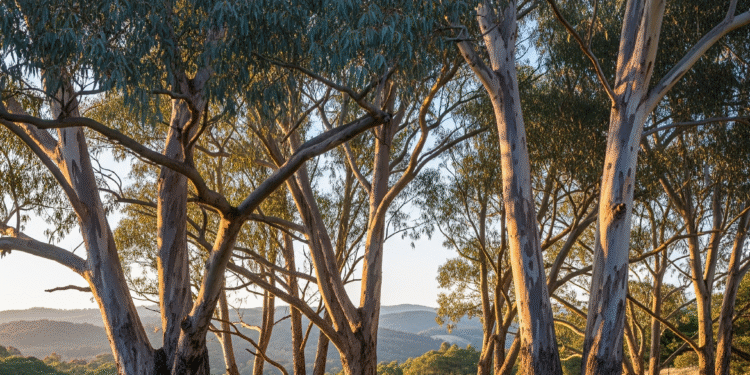Introduction
15 Fast-Growing Trees for Instant Privacy & Shade in Your Yard
Okay, confession time – I was absolutely tired of my neighbor watching me drink coffee in my pajamas every morning. And honestly? They probably didn’t want that view either.
When we moved into our house five years ago, our yard was basically a desert. Zero trees. My wife kept mentioning this gorgeous oak tree she wanted, but come on – I’d be collecting Social Security before that thing actually did anything useful.
That’s when I discovered fast-growing trees, and man, what a revelation. Instead of playing the waiting game like some kind of botanical monk, I actually got results in just a couple seasons.
Now our backyard feels like we’re living in a secret hideaway. We’ve got these amazing towering trees that block out the world, create incredible shade for our summer cookouts, and honestly make our place look like we hired some expensive landscape designer. Plus – and this is the best part – our electric bill dropped like crazy once we got some real shade happening.
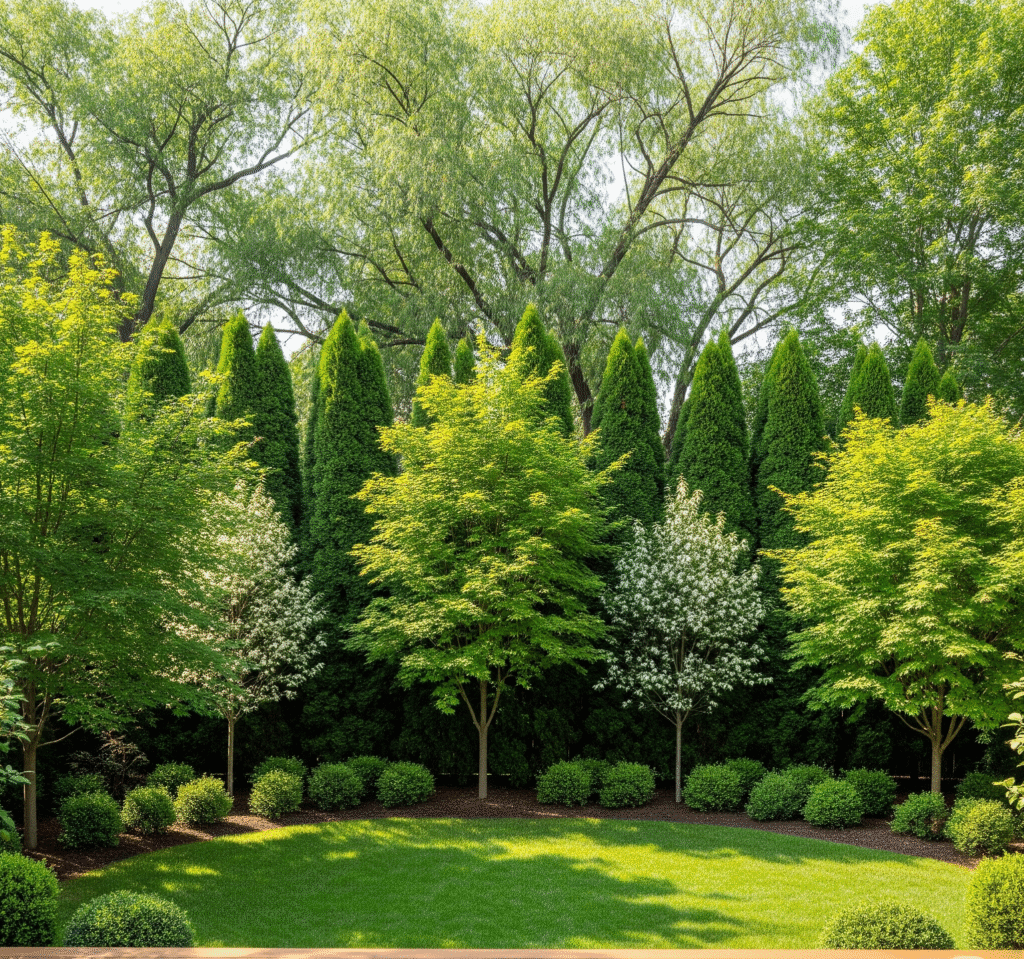
Why Fast-Growing Trees Are Total Game-Changers
Here’s the deal with fast trees – they’re basically nature’s overachievers. While your neighbor’s fancy Japanese maple is still figuring out what it wants to be when it grows up, these speed demons are already towering overhead.
What makes them so crazy fast? They’ve basically evolved to be growth hackers. Softer wood means they can pour all their energy into getting tall instead of building super-dense timber. Those bigger leaves work like solar panels on steroids. And their root systems? Picture aggressive shoppers on Black Friday, grabbing every nutrient they can find.
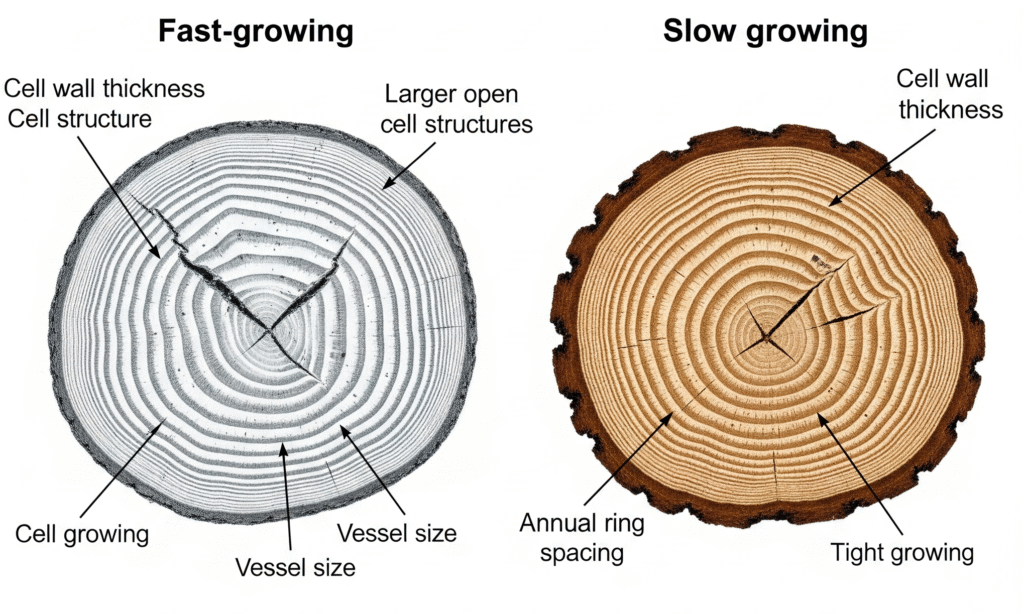
The downside? They won’t outlive your great-great-grandkids like some ancient oak. But honestly, I’d rather enjoy awesome trees while I’m still young enough to climb them with my kids.
Why I’m Completely Sold on These Trees
After trying everything from slow-growing “investment” trees to those crazy expensive mature specimens, here’s why fast trees won me over:
- You actually get to enjoy them – I planted my first Leyland cypress three years ago and it’s already taller than my house
- Your wallet stays happy – A $30 sapling that grows huge beats a $300 mature tree every single time
- Problems get solved immediately – No more awkward eye contact with neighbours or roasting in the sun all summer
- The planet loves you right away – They start pumping out oxygen and sucking up carbon immediately
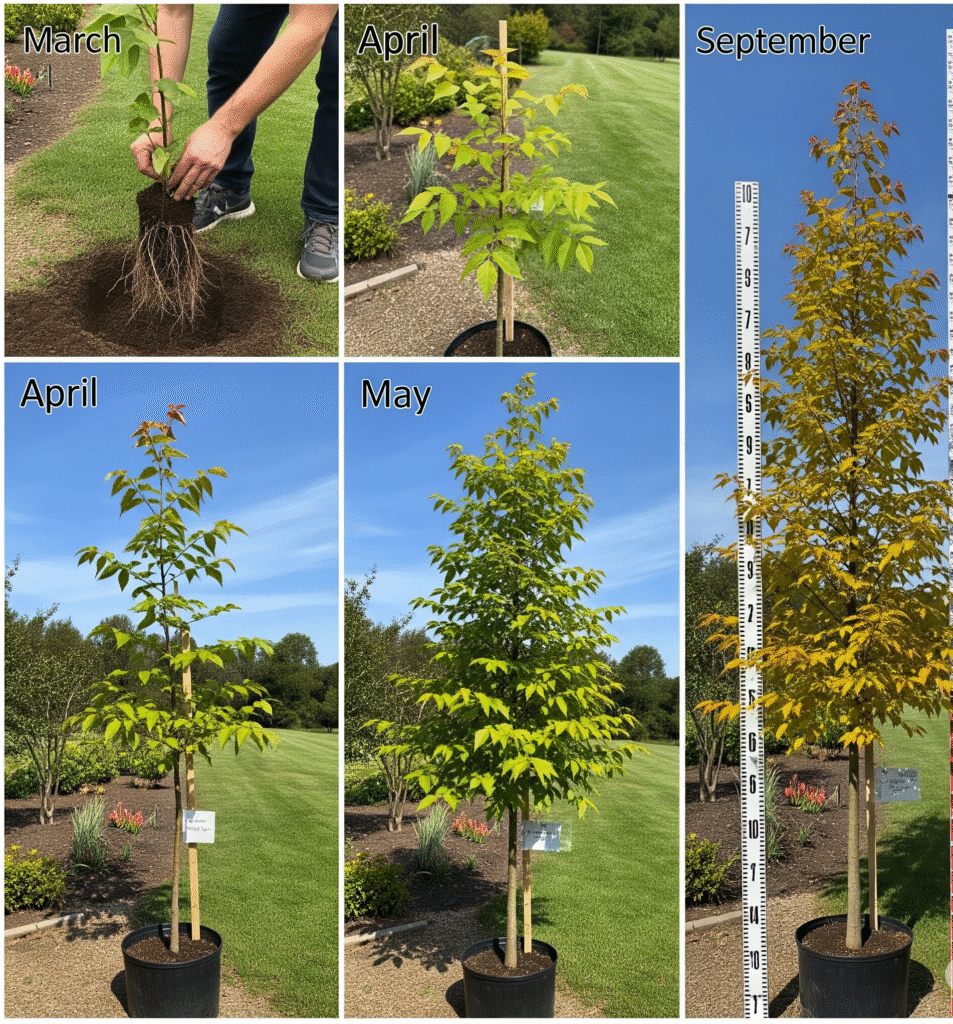
Pro tip I learned the hard way – plant these guys in spring. I tried fall planting once and lost two trees to a brutal winter. Spring gives them the whole growing season to toughen up.
Don’t Make My Expensive Mistakes (Planning 101)
My Location Horror Stories
Oh boy, where do I even start? I’ve made literally every mistake possible, and my wallet is still recovering.
Mistake #1: I planted a Silver Maple just 15 feet from my house because “it looked adorable there.” Three years later, I’m watching branches scrape my roof during every storm and my foundation started cracking. $3,000 tree removal later, lesson learned.
Mistake #2: My buddy planted Lombardy Poplars without checking where his septic system was. Guess who blew his vacation fund on septic repairs?
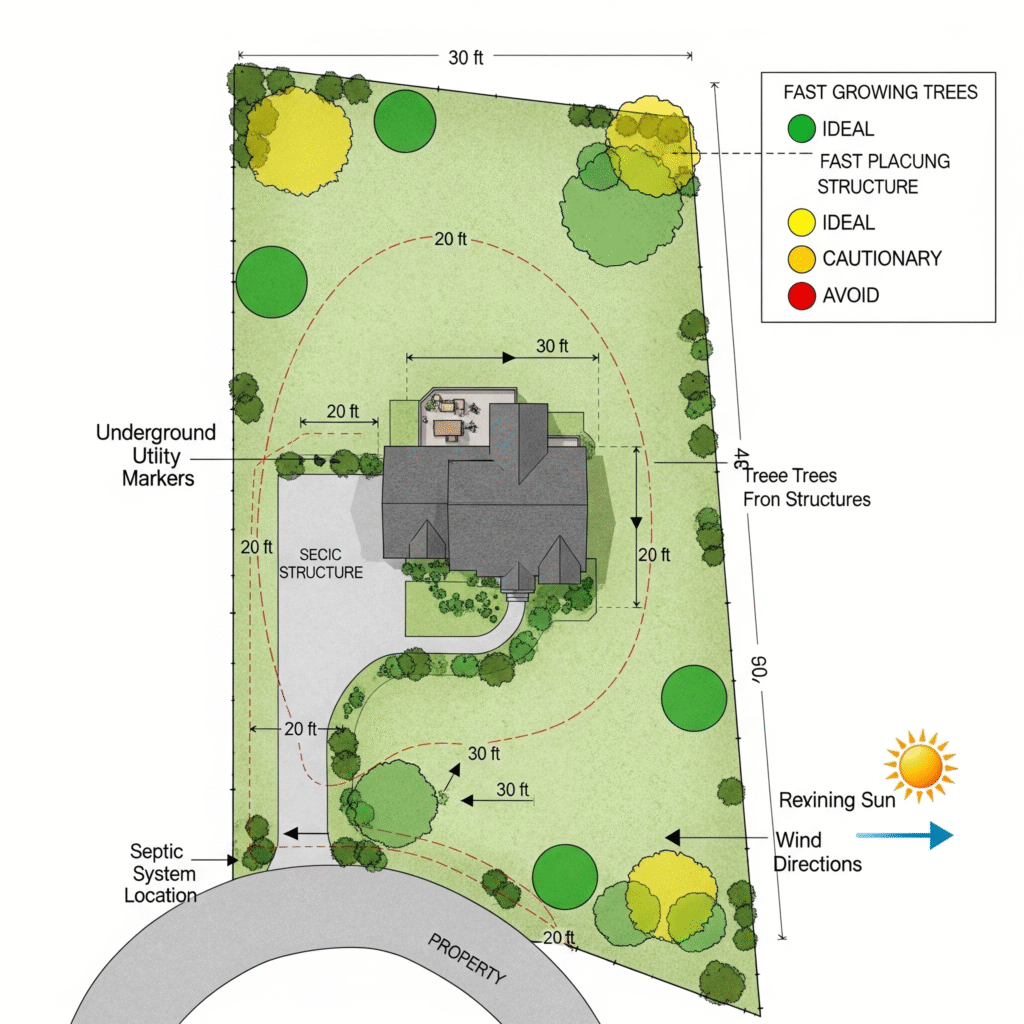
Before you dig that first hole, think like the tree’s gonna be there forever (even though it won’t). Here’s my mental checklist now:
- How massive will this thing actually get? (Google the mature size – don’t just guess!)
- Where are my utilities, septic, and foundation?
- Do I want to block sun or let it through?
- How’s the drainage? (Standing water equals dead tree)
Size Reality Check
People are absolutely terrible at imagining how big trees actually get. That adorable little sapling might be towering over your house in just 10 years.
I’ve watched Lombardy Poplars grow 6 feet in one summer when everything lined up perfectly. Meanwhile, my Japanese Pagoda Tree takes a more civilized 12-15 inches per year. Both have their place, but you’ve gotta know what you’re signing up for.

Always – and I mean always – look up the mature size before planting. I can’t tell you how many times I’ve helped neighbors remove gorgeous trees that just got way too big for their space.
My Top 15 Tried-and-True Fast Growers
1. Bald Cypress – The Swamp Monster (In the Best Way)
Got a soggy spot where everything else just dies? Bald Cypress is your superhero. This native beauty actually laughs at standing water, pests, and basically everything else nature throws at it.
I planted three of these around my retention pond, and they’ve been growing 18-24 inches every single year. Now they’re these absolutely majestic 100-foot giants with 40-foot spreads. The coolest part? Those feathery needles turn this gorgeous rust color in fall before dropping to show off the most beautiful bark underneath.

What it needs: Zones 5-10, loves full sun, actually prefers wet soil, it’s a deciduous conifer (weird but totally cool)
Related : 15 Types of Lawn Weeds That Can Take Over: Your Complete Identification and Removal Guide
2. Chinese Tallow Tree – Gorgeous But a Total Slob
This tree grows 12-18 inches per year into this perfect oval-shaped shade machine. Reaches about 40 feet and puts on an absolutely incredible fall color show that’ll make your neighbors seriously jealous.
But here’s the real deal – it’s a complete slob. Drops flowers, fruits, and leaves pretty much year-round. I learned this the hard way when I planted one right over my deck. Don’t be me. Plant it way in the back corner where the mess doesn’t matter.
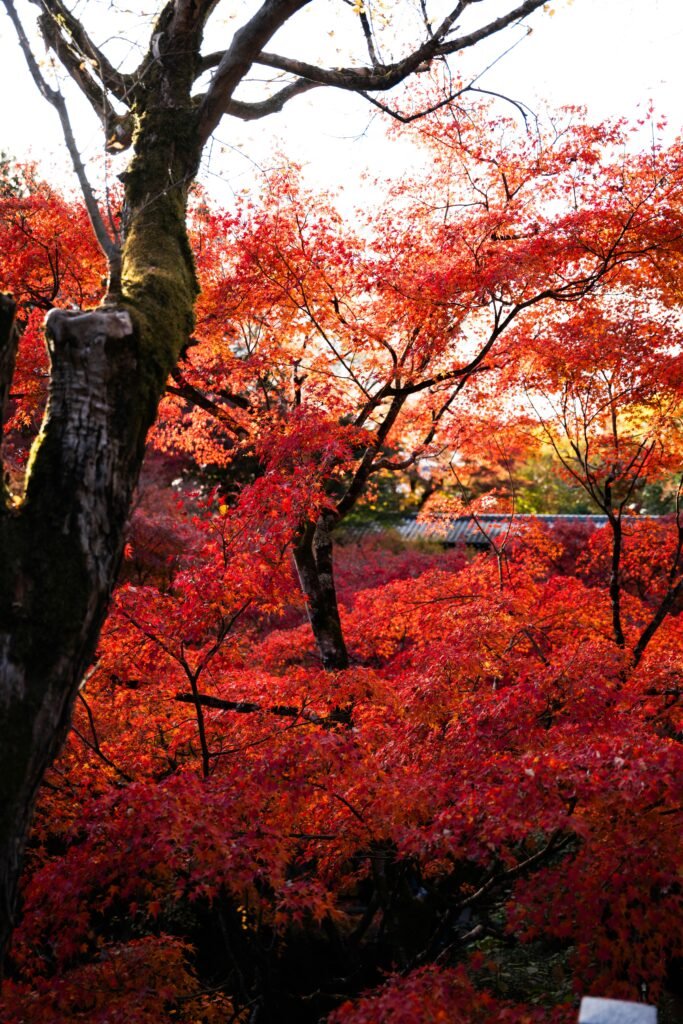
What it needs: Zones 8-10, full sun, well-drained soil. WARNING: Check if it’s banned in your area – some places consider it invasive.
3. Lombardy Poplar – The Speed Demon
Want privacy like yesterday? This is absolutely your tree. We’re talking 6 feet of growth per year when conditions are right. I planted a whole row along my property line and had a solid 40-foot privacy screen in just 5 years.
But man, these trees come with serious baggage. Weak wood means branches break constantly. They’re incredibly messy, attract literally every bug in the neighborhood, and need constant maintenance. Think of them as that high-maintenance friend who’s really fun but totally exhausting.

What it needs: Zones 3-9, full sun to partial shade, moist well-drained soil, and a really high tolerance for maintenance
4. Dawn Redwood – The Total Mind-Bender
This tree will seriously mess with people’s heads. Looks exactly like an evergreen all summer long, then surprise! Drops all its needles in winter like a regular tree. Grows about 2 feet yearly to 80 feet tall and 25 feet wide.
I planted one in my back corner five years ago, and it’s become this absolutely incredible focal point. Those soft needles turn these gorgeous red-brown colors in fall before dropping to reveal this perfectly symmetrical branching pattern.
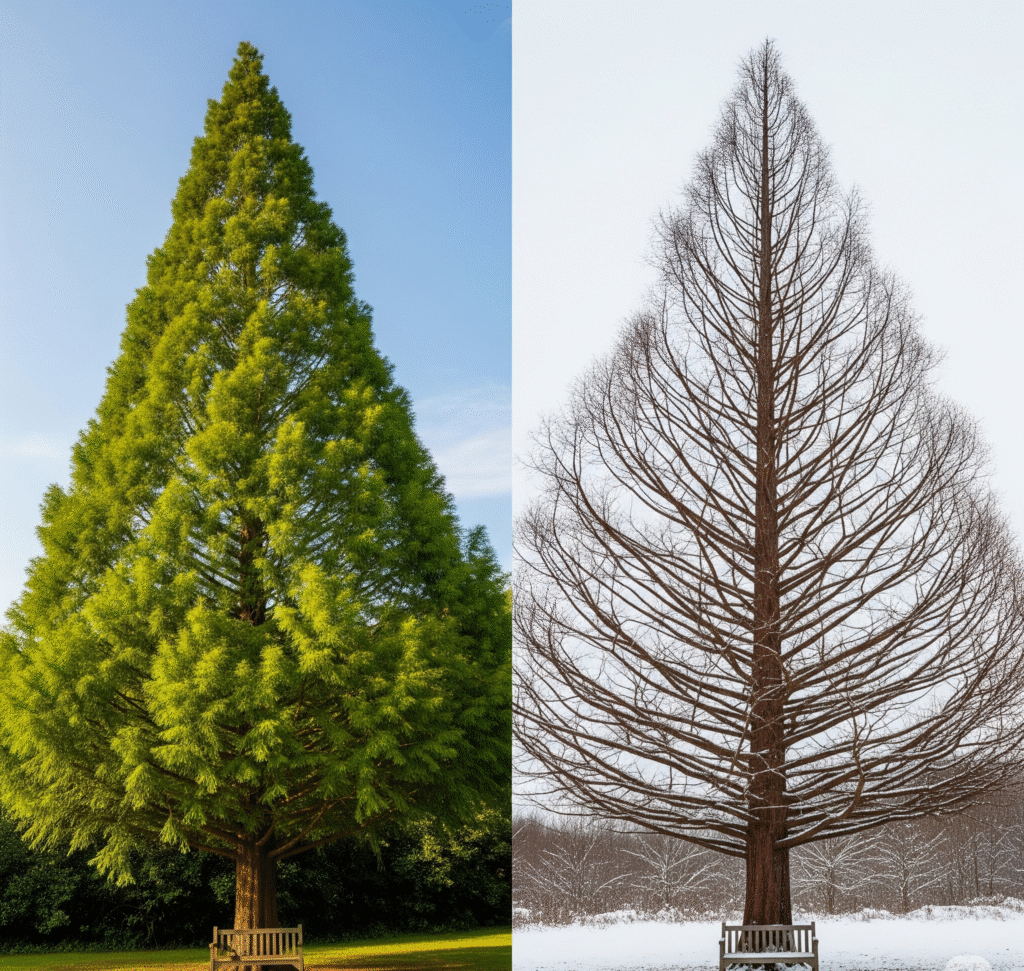
What it needs: Zones 4-8, loves moist soil, needs full sun, give it tons of space
5. European Black Alder – The Wet Spot Savior
Remember that soggy corner where absolutely nothing grows? Black Alder will actually thrive there. The root system on this thing is absolutely insane – we’re talking 16 feet of spread. Great for handling wet conditions, terrible news for sidewalks and sewer lines.
Grows super fast when young, then settles into a more reasonable 12-15 inches annually. Eventually hits 40-60 feet tall and 20-40 feet wide. Just keep it far away from anything you don’t want roots messing with.
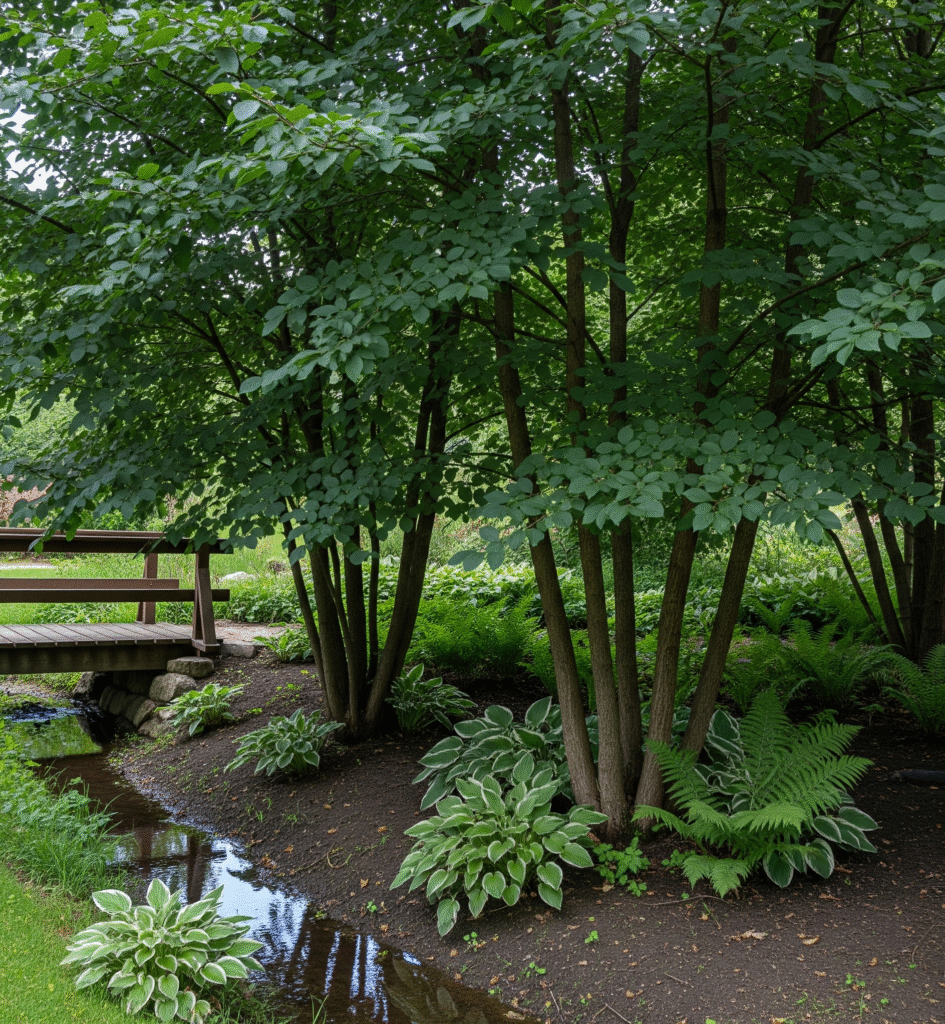
What it needs: Zones 4-8, damp soil, full sun/partial shade. Definitely check if it’s invasive in your area.
6. Eucalyptus – West Coast Wonder
If you’re out west, these are absolute champions. Hundreds of varieties ranging from 25-70 feet, growing 2-3 feet yearly. That silvery-blue foliage is just stunning, and the smooth bark looks like natural art.
One major catch though – they absolutely hate humidity. If you’re in the Southeast, just forget it. But in dry Zones 9-10? They’re incredible for privacy and shade.
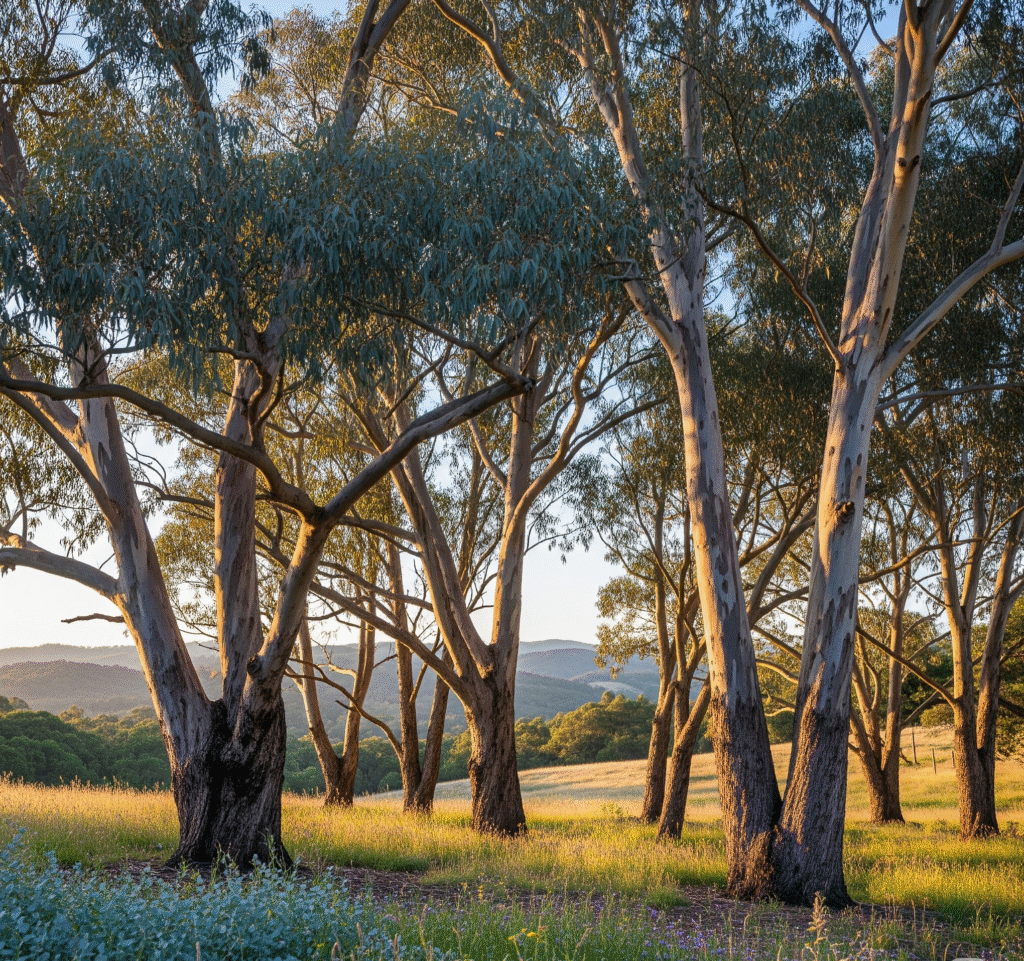
What it needs: Zones 9-10, full sun, well-drained soil, dry climates only
7. Japanese Pagoda Tree – The Set-It-and-Forget-It Champion
This is seriously my lazy gardener’s dream tree. Grows 12-15 inches yearly to 75 feet tall and wide. Develops this gorgeous wide crown and produces these creamy, incredibly fragrant summer flowers that smell amazing.
City folks absolutely love these because they handle heat, pollution, and drought like total champions. I’ve seen them thriving right next to busy highways where other trees would just give up completely.
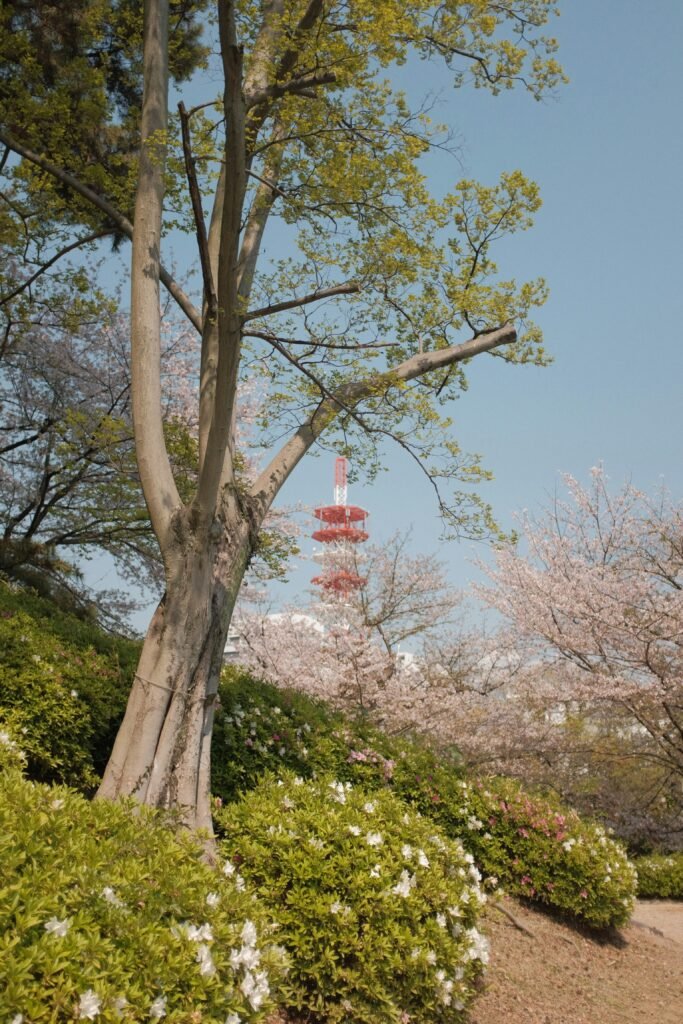
What it needs: Zones 6-8, full sun/partial shade, rich well-drained soil, practically zero maintenance
8. Lemon Bottlebrush – The Hummingbird Magnet
Okay, technically it’s a shrub, but it acts exactly like a tree and shoots up 10-15 inches yearly to 25 feet. The flowers are absolutely incredible – bright red brushes that actually smell like lemons when you get close.
Every single hummingbird in the neighborhood basically camps out at mine during bloom season. Handles southern heat and drought like a total boss. Northern folks can grow it in containers and bring it inside for winter.
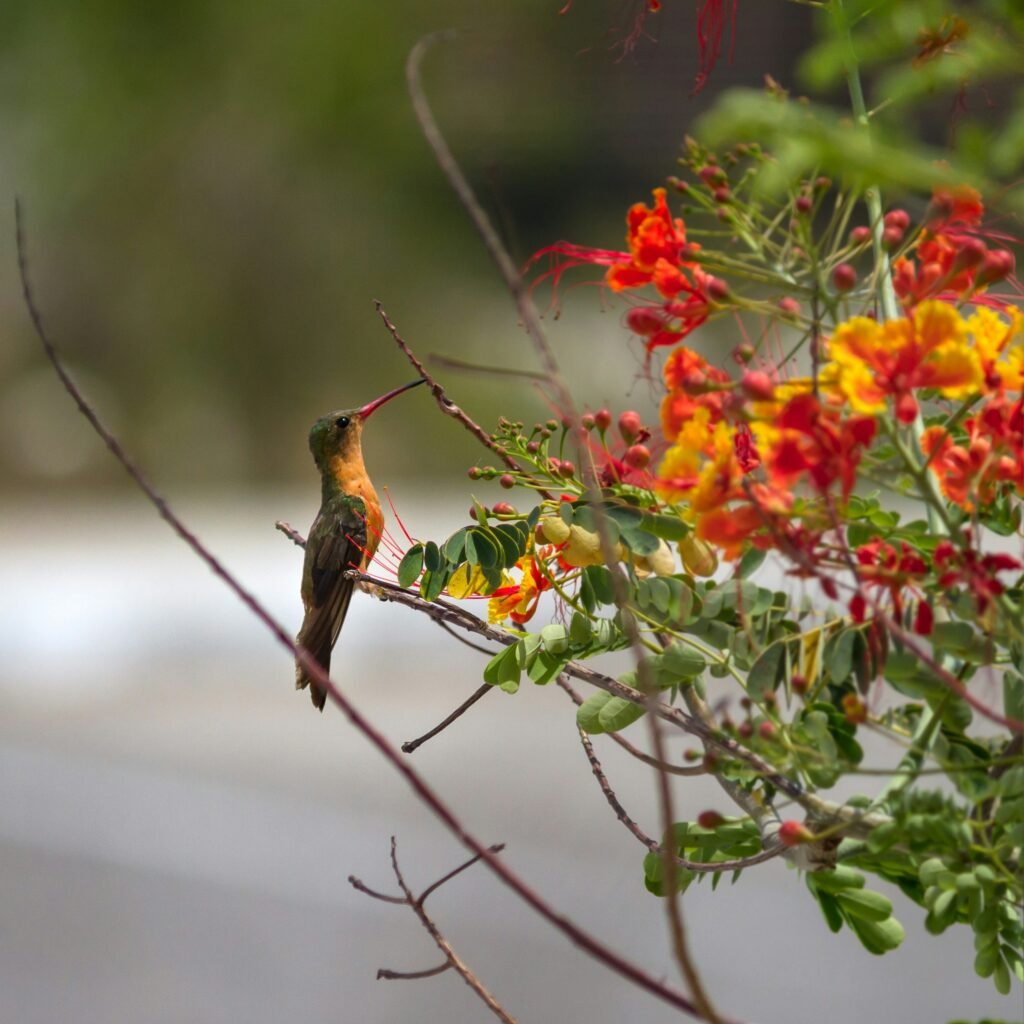
What it needs: Zones 9-10, full sun/partial shade, well-drained soil, totally container-friendly
9. Leyland Cypress – The Ultimate Control Freak Tree
This is hands-down the most versatile tree I’ve ever worked with. Plant one as a gorgeous specimen, or line them up for a perfect hedge. Grows 1-3 feet yearly and can hit 50-70 feet if you just let it go wild.
The absolute beauty is you have total control. Regular pruning keeps them exactly whatever size you want. I maintain an 8-foot privacy hedge that’s been the exact same height for three years now. Perfect for when you want privacy but not a whole forest.
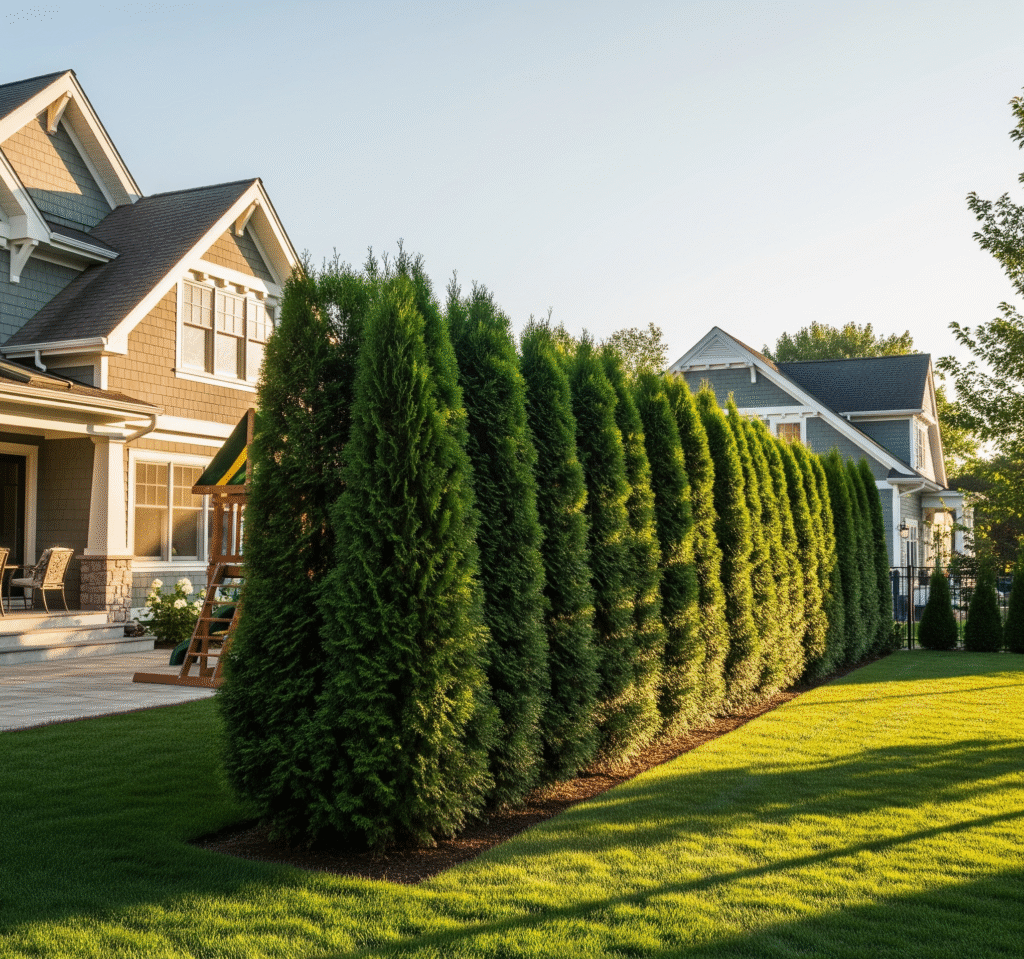
What it needs: Zones 7-10, full sun, well-drained soil, regular pruning
10. Silver Maple – The Shade Monster
This tree is literally everywhere in America for really good reason. Grows 1-2 feet yearly and gets absolutely massive – 100 feet tall and 70 feet wide. The shade is incredible, but that shallow root system and weak wood will definitely cause headaches.
Red Maple is the much better-behaved smaller cousin at 50 feet tall and 40 feet wide. But wow, those fall colors are so bright they look almost fake.
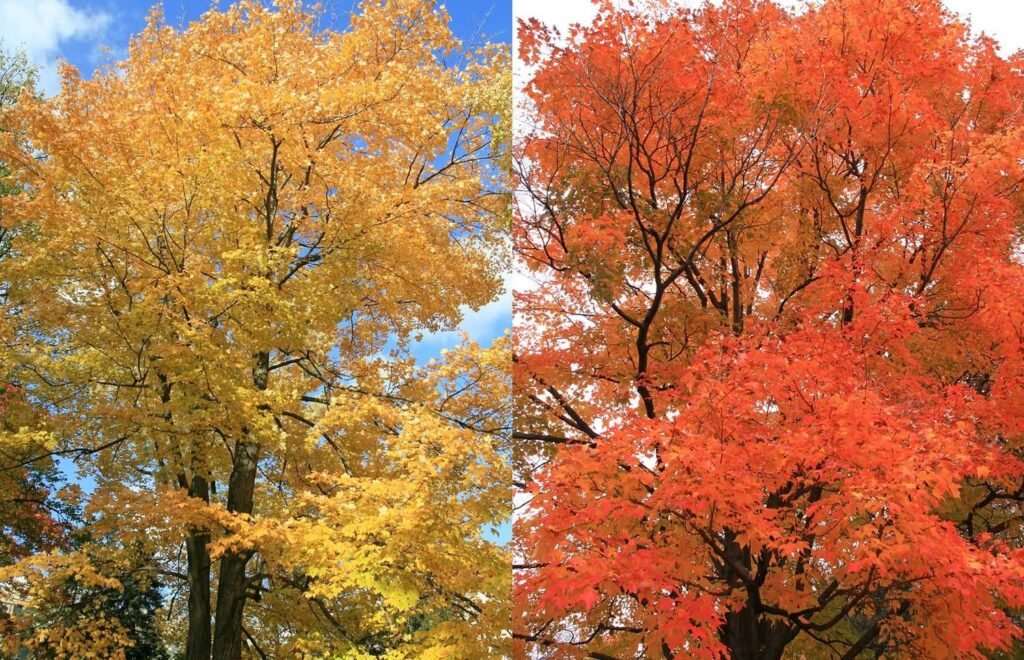
What it needs: Zones 3-9, full sun/partial shade, well-drained soil, really careful placement
11. Tulip Tree – The Total Showstopper
This tree literally makes people stop their cars and ask questions. Those tulip-shaped yellow-orange flowers in spring are absolutely gorgeous, and the leaves are unlike anything else you’ll see. Grows 15-18 inches yearly to 100 feet.
The wood is pretty weak, but if you train young trees to develop good branch structure, you can prevent most problems. Totally worth the effort for those incredible flowers and unique foliage.
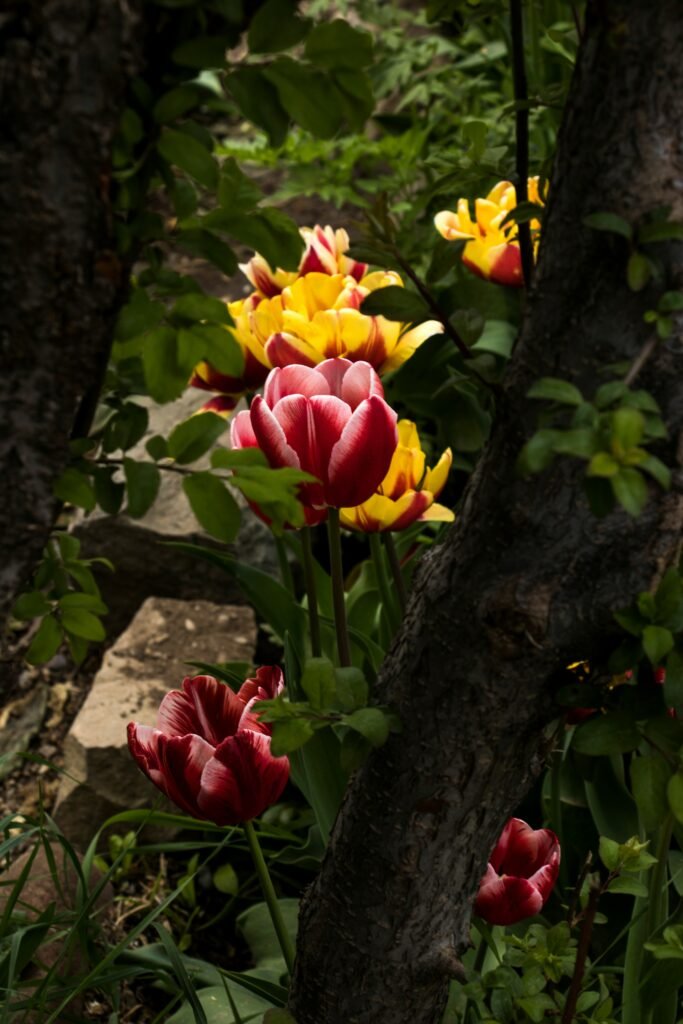
What it needs: Zones 5-9, full sun/partial shade, well-drained soil, training when young
12. Eastern White Pine – Pure Class
If you want total elegance, this is absolutely your tree. Those soft, fine needles and graceful branching create this incredibly sophisticated look. Grows 12-15 inches yearly to 100 feet.
The blue-green color is gorgeous year-round, and that pyramidal shape is just perfect. Great for privacy or as a stunning specimen tree. Native bonus points too.
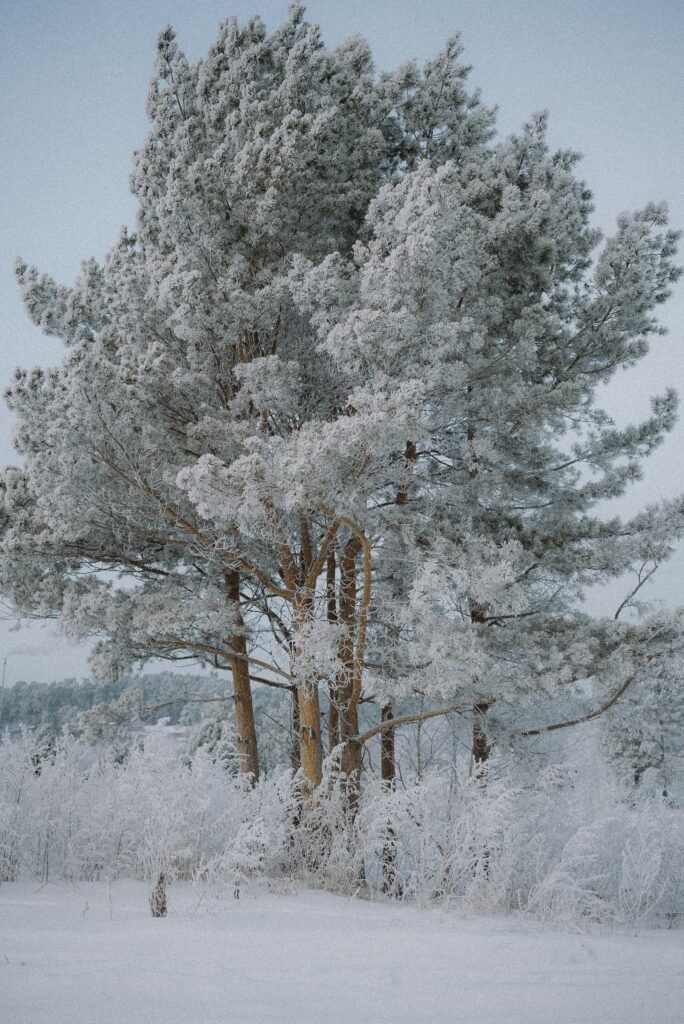
What it needs: Zones 3-8, full sun preferred, well-drained soil, native to North America
13. Southern Catalpa – Old-School Charm
There’s something really charming about this totally old-fashioned shade tree. Pretty white spring flowers, followed by those long skinny seedpods that hang like decorations. Grows 12-15 inches yearly to 40 feet.
Those seedpods are pretty messy though, so definitely don’t plant it near your patio or main walkways. Perfect for the backyard where you want character and don’t mind some natural clutter.
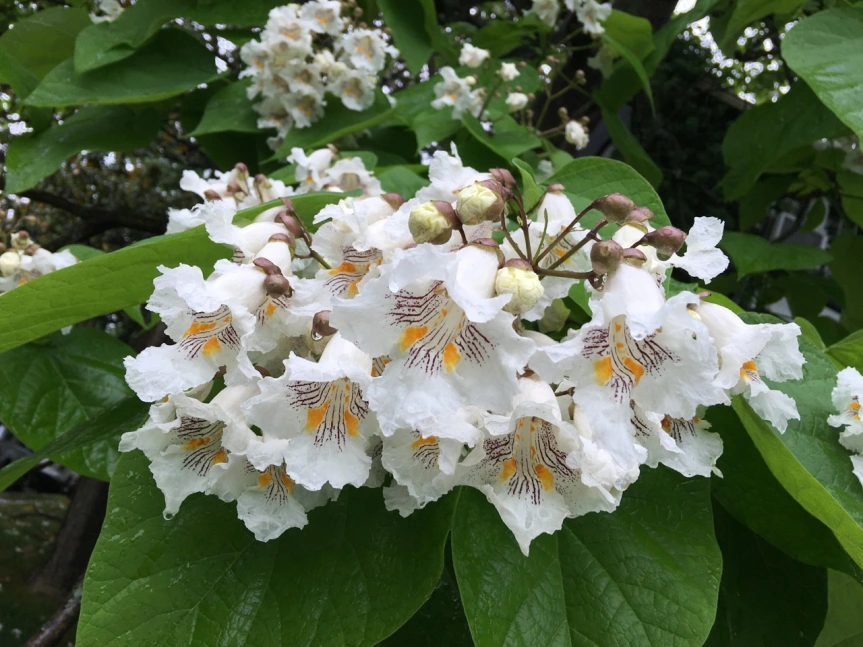
What it needs: Zones 5-9, full sun, well-drained soil, backyard placement
14. Crape Myrtle – Four Seasons of Pure Awesome
Not the biggest tree (25 feet) but absolutely perfect for smaller spaces. Fast growth, incredible summer flowers, fantastic fall foliage, and that smooth mottled bark looks amazing in winter. It’s like getting four completely different trees throughout the year.
Southeastern gardeners are totally obsessed with these, and I completely get why. They handle heat and drought like champions and look fantastic doing it.
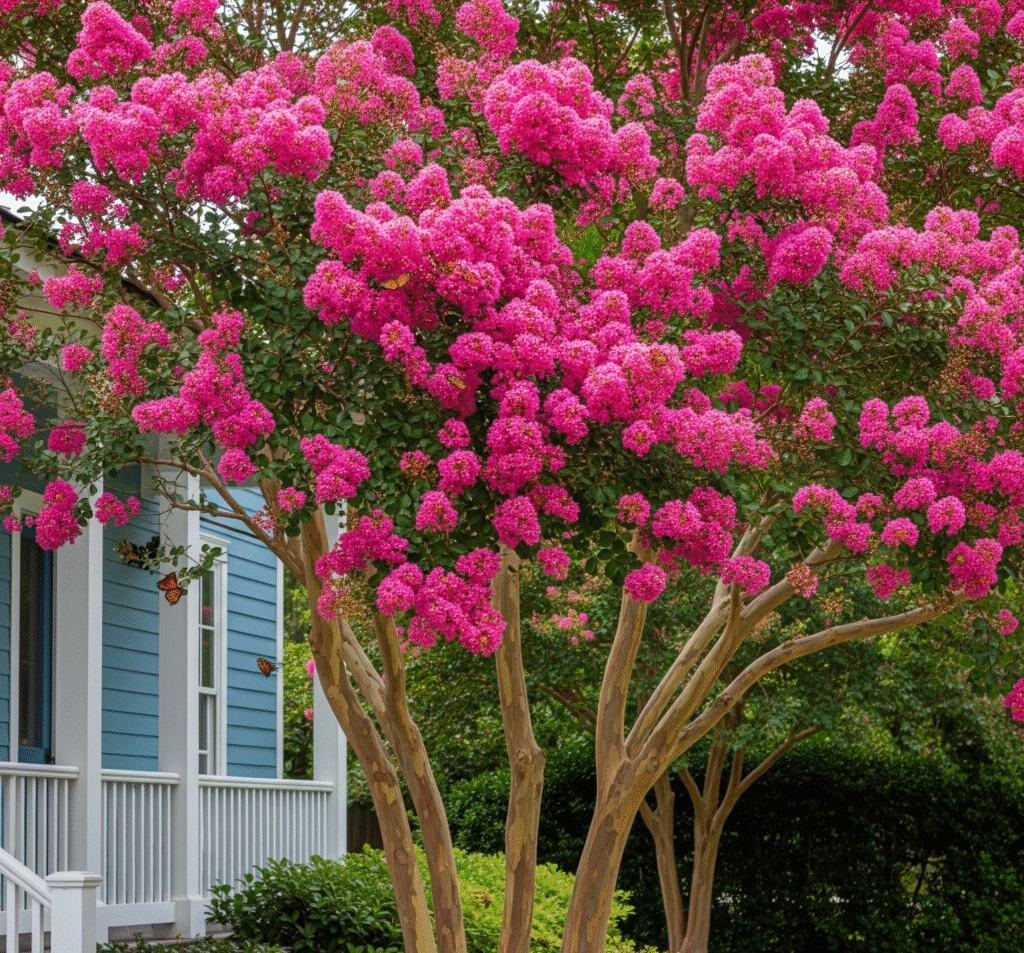
What it needs: Zones 6-10, full sun preferred, evenly moist soil
15. Eastern Redbud – The Native Beauty
This native reaches 7-10 feet in just five years and tops out around 20-30 feet. Those pretty pink spring flowers are absolutely beloved by every pollinator in the neighborhood.
Handles partial shade just fine but flowers way better in full sun. Once it’s established, it’s incredibly drought tolerant and basically takes care of itself.
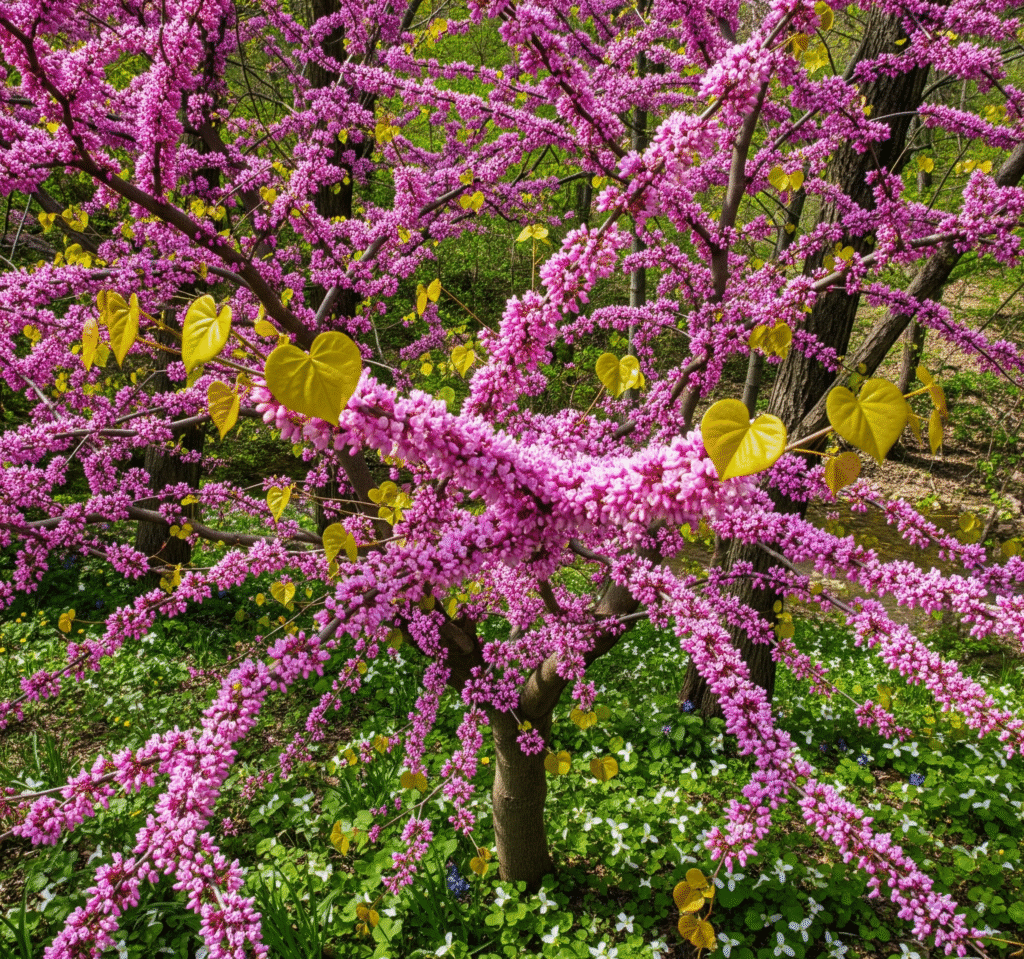
What it needs: Zones 4-9, full sun for best flowering, any soil type, drought tolerant once established
Matching Trees to Your Actual Needs
Privacy Screens That Actually Work
After trying different combinations, here’s what really delivers results:
Leyland Cypress is my absolute go-to. Dense evergreen foliage, you control the exact size, and it actually stays put where you plant it. I space mine 6-8 feet apart for solid coverage.
Lombardy Poplar works great for narrow spaces. Plant them 4-6 feet apart and you’ll have a living wall in no time. Just be ready for all the maintenance drama.
Dawn Redwood is perfect for larger properties where you want substantial privacy without feeling totally cramped.
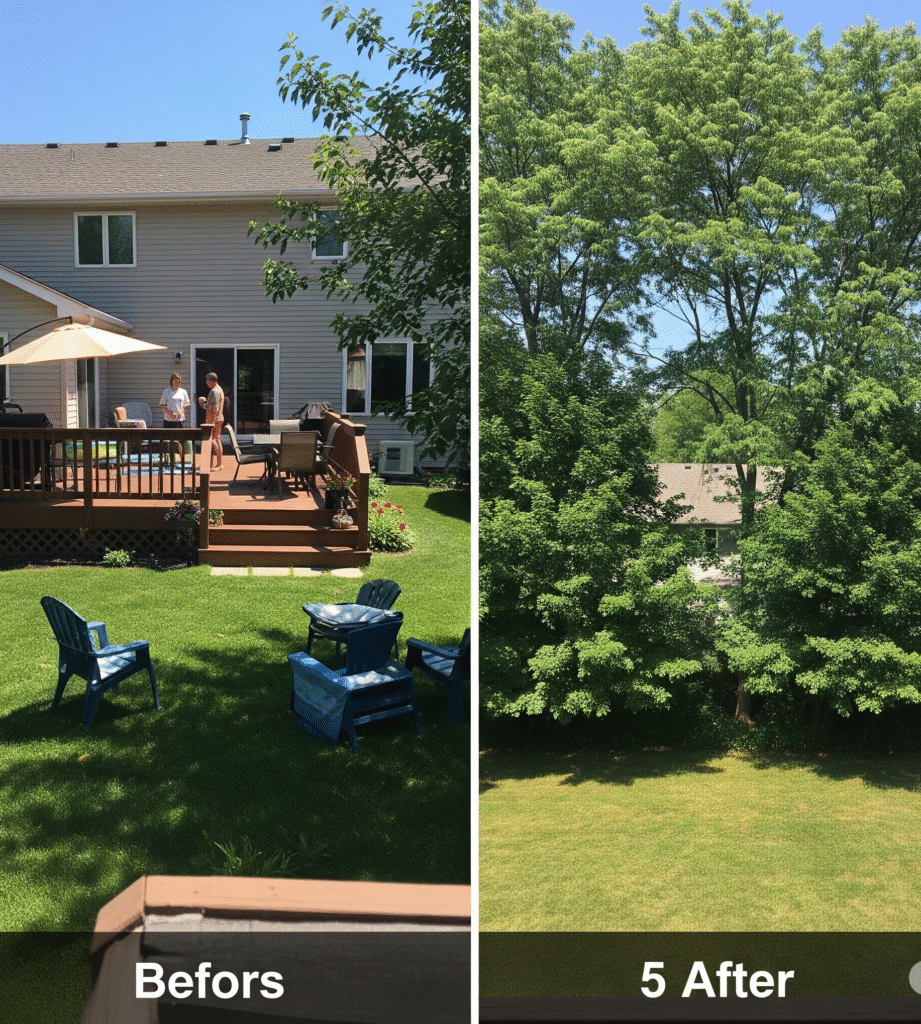
Shade Trees That Actually Shade
Nothing beats natural air conditioning. These are my proven shade champions:
Silver Maple creates absolutely massive shade coverage, though you need to be really smart about placement because of that weak wood situation.
Tulip Tree gives you gorgeous flowers AND substantial shade. Best of both worlds.
Japanese Pagoda Tree handles urban conditions like a total champ while providing excellent shade.
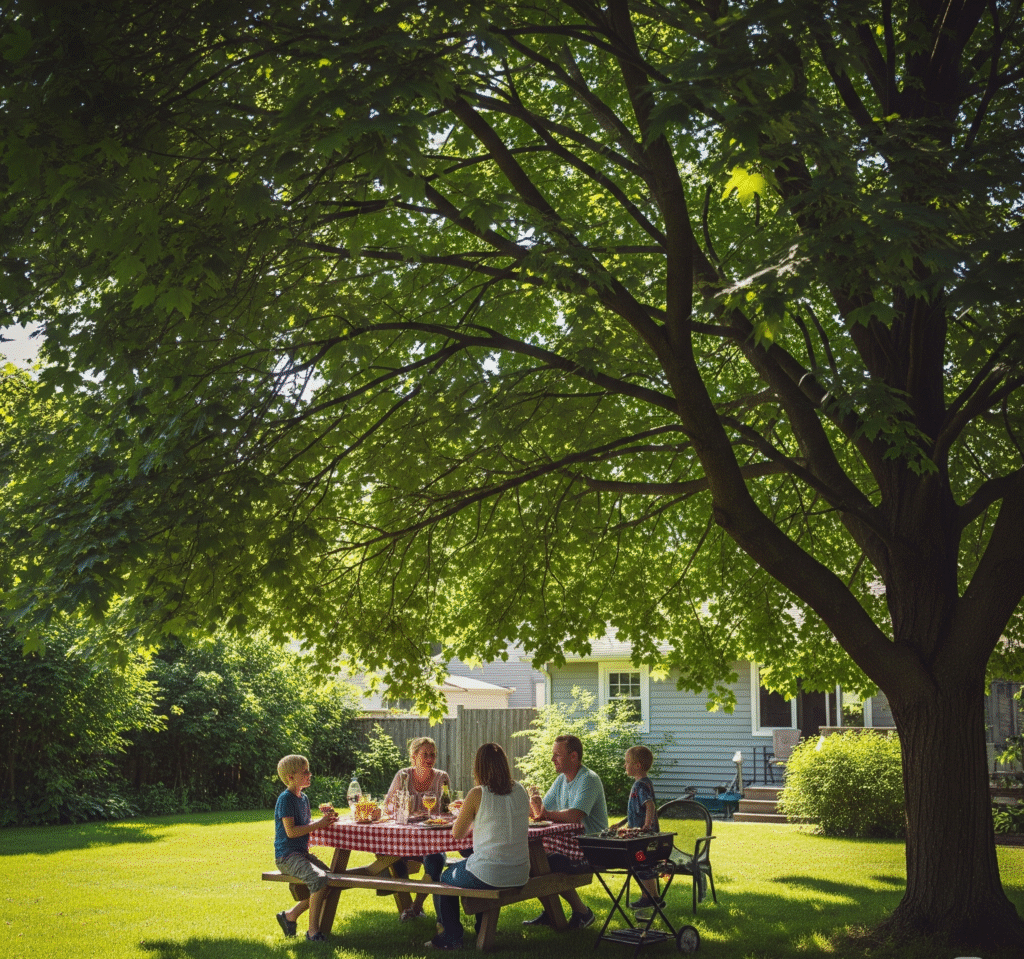
Windbreaks That Actually Work
Eastern White Pine gives year-round protection with dense needles that don’t disappear in winter.
Bald Cypress handles extreme weather like a total boss while providing substantial wind barrier.
Eucalyptus (in suitable climates) creates incredibly strong, vigorous windbreaks.
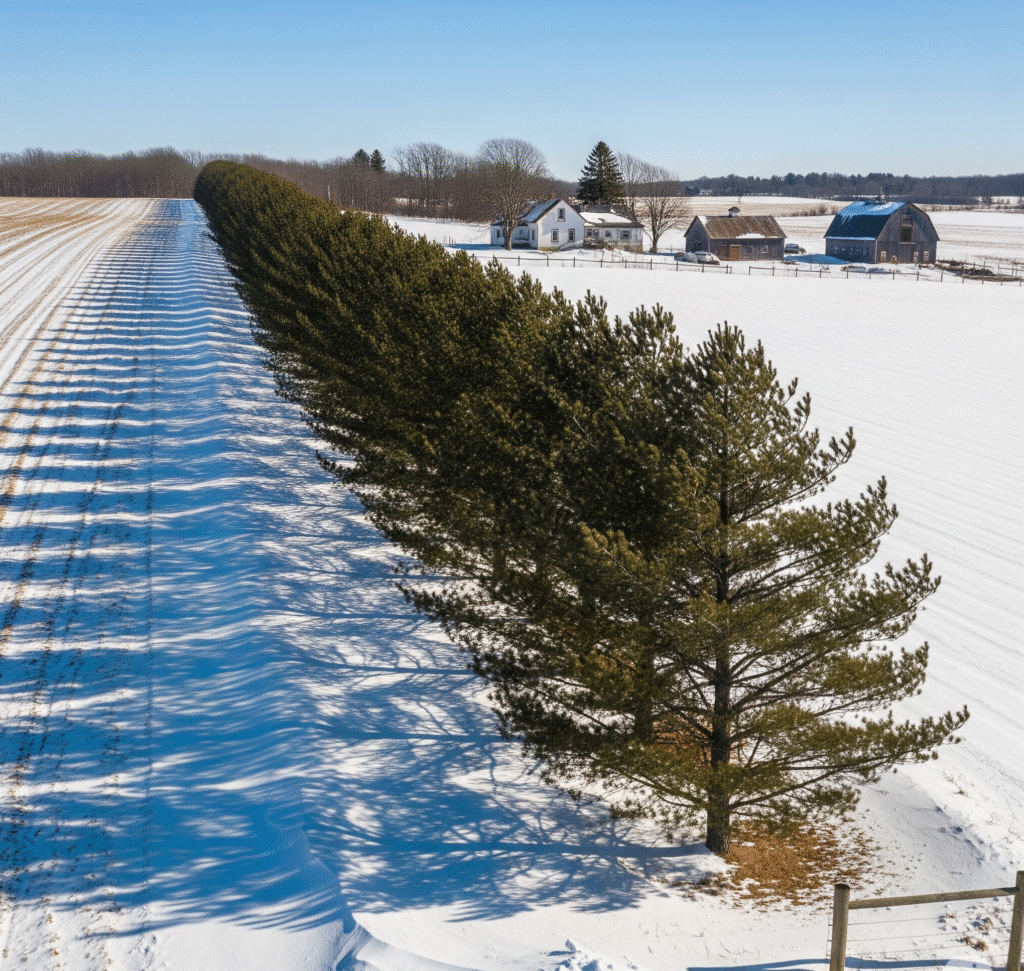
Planting Without Totally Screwing Up
Timing Is Absolutely Everything
Spring planting has saved my butt more times than I can count. Soil’s warming up, rain comes naturally, and trees get the whole growing season to establish roots before winter really tests them.
Fall can work in cooler regions, but I’ve lost too many trees to unexpected cold snaps. Summer and winter planting? Only if you’re committed to babying them constantly.
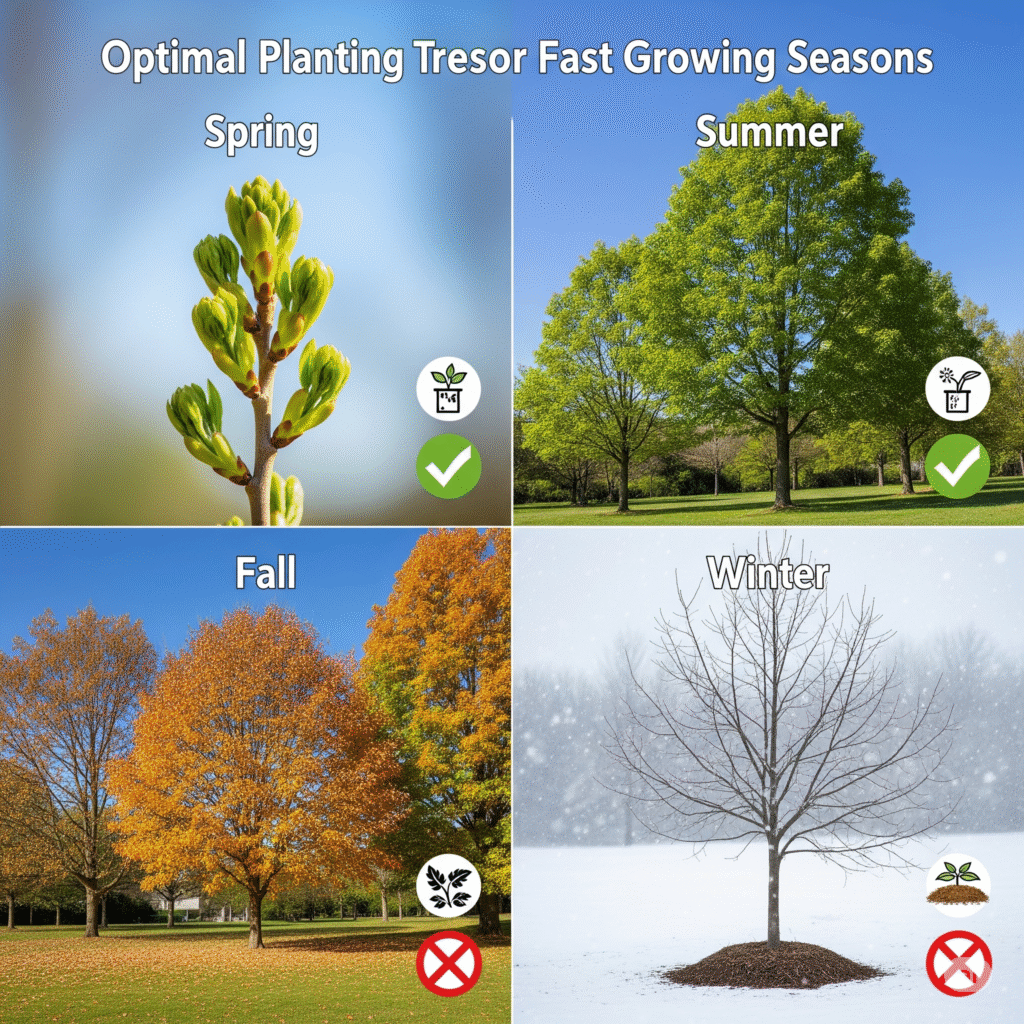
The Actually Right Way to Plant
After killing my fair share of trees, here’s what actually works:
- Test your soil first – pH between 6.0-7.0 is the sweet spot for most trees
- Check drainage – standing water kills trees faster than anything else
- Dig the hole right – 2-3 times wider than the root ball, exact same depth
- Position correctly – root flare should be right at ground level, not buried

Keeping Them Alive and Actually Happy
Fast-growing trees are exactly like teenagers – they need way more food and water than everyone else:
- Deep watering – 1-2 inches weekly the first year including rain
- Feed them regularly – balanced fertiliser (10-10-10) in spring, slow-release in summer
- Mulch properly – 2-4 inches around the base, keep it away from the trunk
- Consider drip irrigation – best investment I ever made for consistent moisture
The Maintenance Reality Check
Pruning – Totally Not Optional
Fast trees need regular haircuts. That rapid growth and softer wood means they’ll get messy and potentially dangerous without proper maintenance.
Year 2 – Start structural pruning to develop strong branches
Every year – Remove dead, diseased, crossing branches
Safety first – Cut anything threatening your house, power lines, or people
Winter timing – Late fall to early spring when they’re dormant
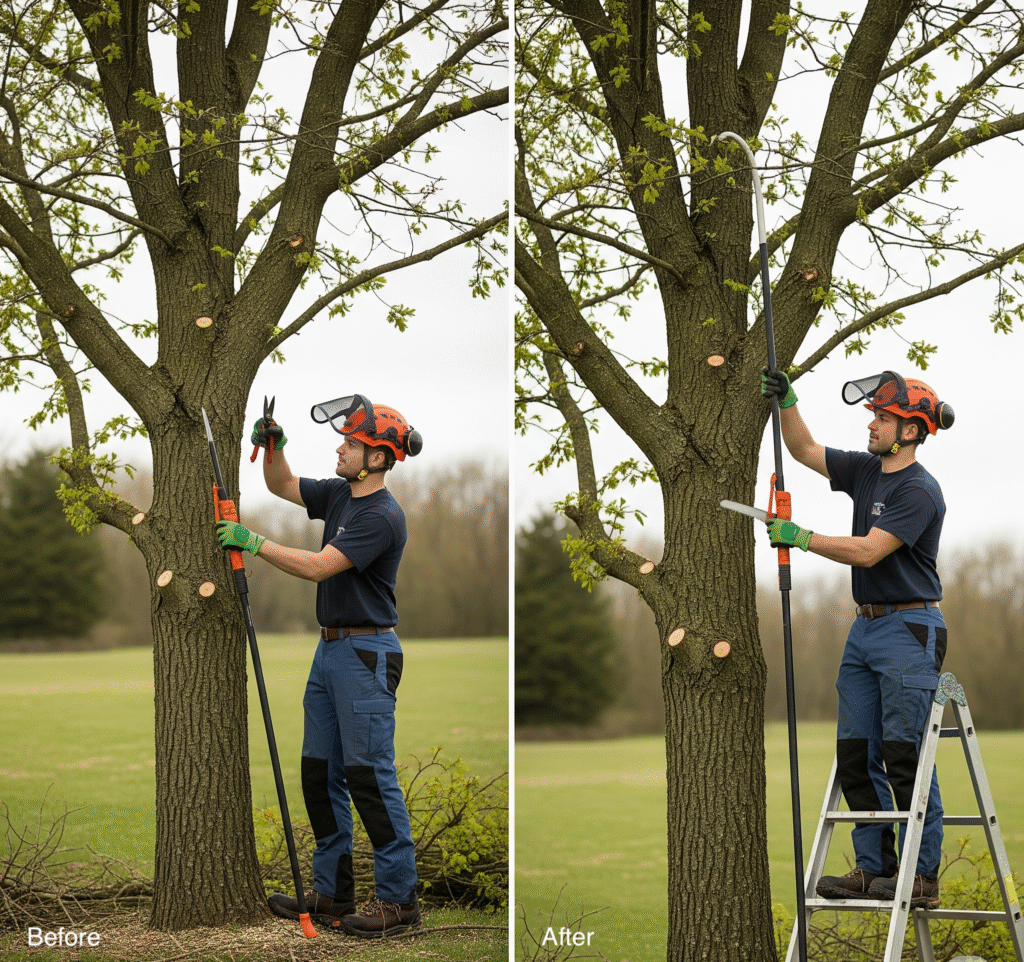
Problems You’ll Actually Face
Let me be totally honest about what you’re signing up for:
Storm damage – Weak wood breaks. Regular pruning helps but won’t eliminate the problem completely.
Bug parties – Fast growth attracts pests. Check regularly and treat early when you spot issues.
Aggressive roots – Some species will absolutely mess with foundations, septic systems, and sidewalks.
Watch for yellowing leaves, stunted growth, brittle branches, trunk cracks, or leaning. When in doubt, call a certified arborist.
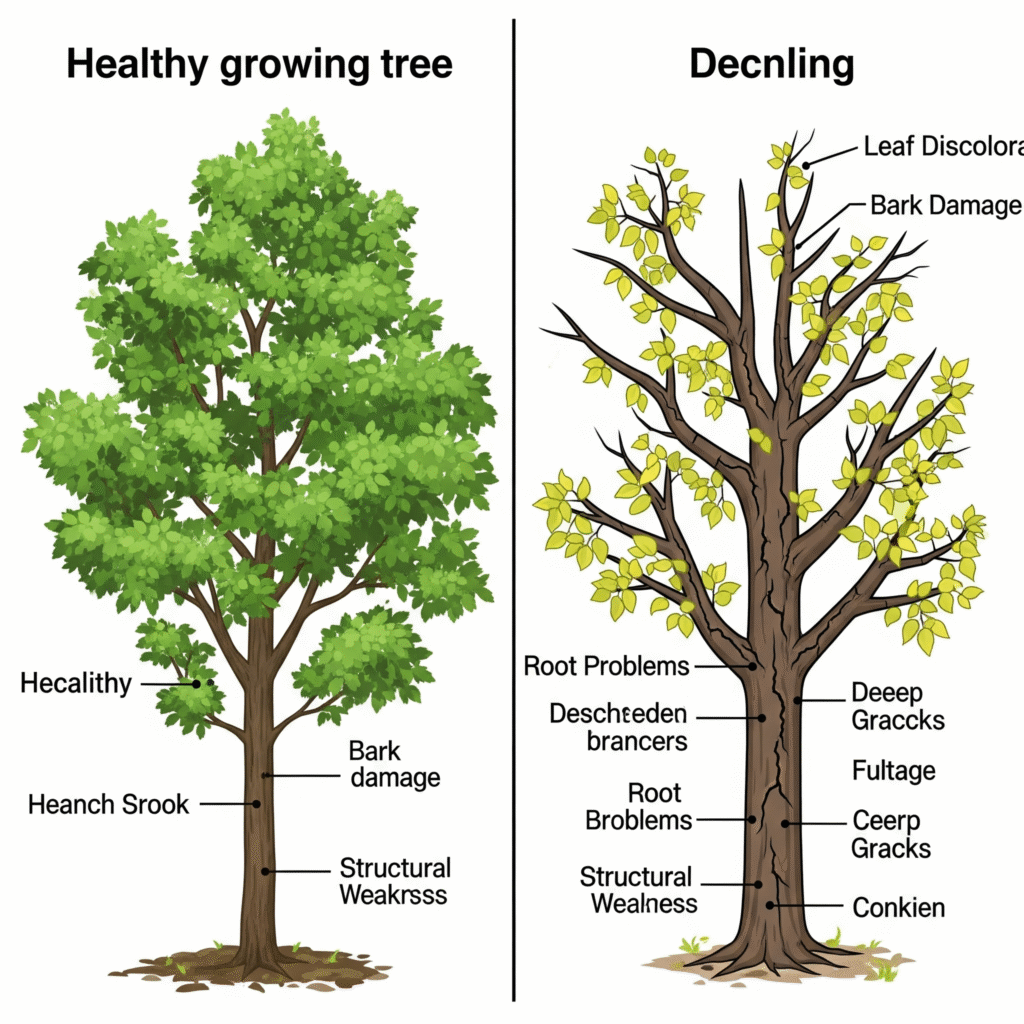
Spacing That Actually Makes Sense
Privacy screens – Overlap canopies by 25-50% for solid coverage
Shade trees – Full mature spread plus 10-20 feet breathing room
Windbreaks – 15-20 feet between trees, 30-40 feet between rows
Quick rule – Divide mature height by 3 for minimum spacing
Regional Reality Check
Northern Zones (3-5) – Winter Warriors
- Eastern White Pine
- Red Maple
- Eastern Redbud
- Dawn Redwood
Middle Zones (6-8) – The Sweet Spot
- Japanese Pagoda Tree
- Tulip Tree
- Southern Catalpa
- Most maples
Southern Zones (9-10) – Heat Lovers
- Lemon Bottlebrush
- Eucalyptus
- Chinese Tallow Tree
- Crape Myrtle
Local Rules Actually Matter
Many fast trees are banned in certain areas because they can totally take over. Before you buy anything, definitely check with your local extension office. Some alternatives:
- Instead of Chinese Tallow → Native Red Maple
- Instead of Lombardy Poplar → Native Cottonwood
- Instead of European Black Alder → Native River Birch
The Money Talk
Why This Investment Actually Pays Off
Let me break down the real numbers from my own experience and what I’ve seen with neighbors:
Upfront costs – I spent $150 on three young Leyland Cypress trees. A mature tree that size would’ve cost me $1,500+ each. That’s serious money saved right there.
Property value boost – My realtor friend says mature trees can bump property values 3-15%. When I got my house appraised last year, the landscaping added $8,000 to the value.
Energy savings – This one totally shocked me. My electric bill dropped $200+ per month in summer once my shade trees got established. Over 10 years, that’s $24,000 in savings.
Maintenance costs – Yeah, they’re higher than slow trees, but the benefits start immediately instead of in 30 years.
Fast vs. Slow – The Real Comparison
Fast Trees Win At:
- Actually enjoying benefits while you’re still alive
- Lower upfront investment for the results you get
- Solving problems quickly (privacy, shade, etc.)
- Earlier property value boosts
Slow Trees Win At:
- Living 100+ years vs. 30-50 for fast ones
- Handling storms better (stronger wood)
- Less maintenance headaches
- Better long-term wildlife habitat
Honestly? I’d rather enjoy 30-50 years of awesome trees than wait 30 years for slow ones to start mattering.
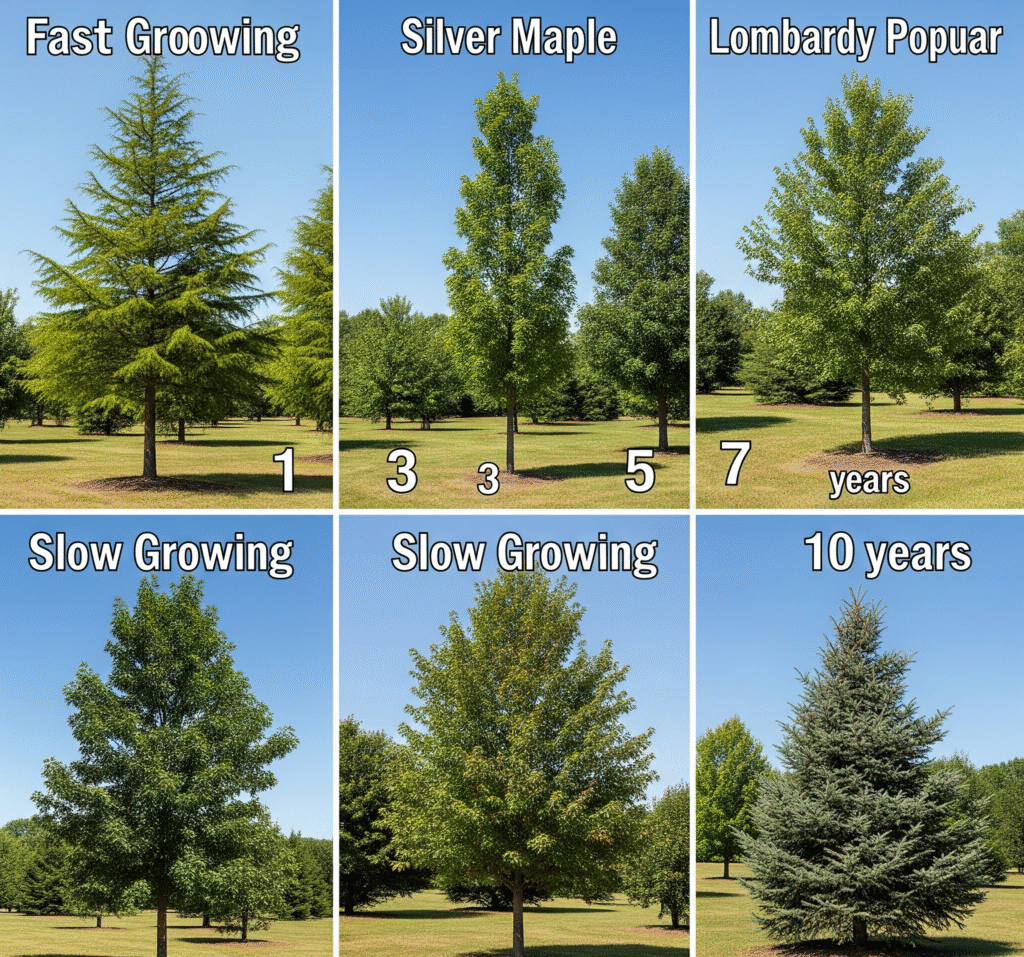
How fast do they really grow?
Most give you 1-4 feet per year. My Lombardy Poplars hit 6 feet one crazy year when everything was perfect. You’ll see real benefits in 5-10 years instead of waiting 20-30 like with traditional trees.
How long do they actually live?
Typically 30-50 years vs. 100+ for slow growers. That’s the trade-off, but honestly, I’ll enjoy 30-50 years of awesome trees rather than plant something for my grandkids to appreciate.
How close to my house is actually safe?
I keep most at least 20-30 feet away, more for the really big ones. Think about both the canopy and roots – they typically spread 1-3 times the tree’s height.
Best trees for privacy?
Leyland Cypress is my top pick (evergreen, dense, totally controllable). Dawn Redwood for big properties. Lombardy Poplar for narrow spaces. Choose evergreens if you want year-round privacy.
